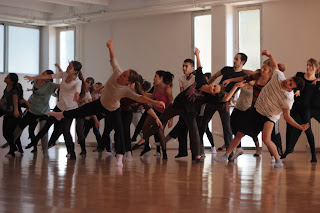I was approached a few weeks ago by one of the teachers at the Conservatoire and he informed me of a Contemporary dance group that wanted me to teach for them. The group seems similar to a society within the university, although the dancers had to audition to gain a place. To begin with there were two groups, Modern Dance and Dance Theatre. This year the two have been merged to create one larger group.
Before teaching all I was told is that some were dancers and some did not have much experience of dance, but they had all been chosen at audition. I created a class of about an hour and a half in length and then thought up a few choreographic tasks to maybe use towards the end of class.
The group was rather big, there must of been around 35/40 students. The studio space was great though and large enough for everyone.
I think I may have set the class at slightly too high a standard, however everyone put it the effort and overall the first class was rather successful. I left a few exercises out as I felt they were too difficult and I also ran out of time so did not work on any choreographic tasks. Last weeks class I continued working on the phrases and exercises from the first class as I wanted the students to get them into their bodies a bit more, enabling them to perform the phrases without me. I also added a couple new phrases in, including a rather difficult traveling phrase which they all seemed to enjoy.
Although I do speak Turkish pretty fluently, teaching dance is completely different. I guess I never realised until now how different dance language is to everyday language that we use! I speak enough Turkish to easily get by day to day but trying to explain that the movement is 'initiated from the hip joint', for example, is another story. This means that teaching contemporary dance here has been more of a challenge than usual, but still just as enjoyable.
Last week, the lovely students had bought me a gift to say thank you (even though I don't feel I have done that much for them yet!). It was a traditional Turkish coffee set which I love. I'm having lots of fun teaching these students and look forward to working with them more during my last couple of weeks here in Izmir.
 |
| Traditional Turkish coffee set as a gift from my dance students. |















































